Log in or create new account to save this product to your wishlist.
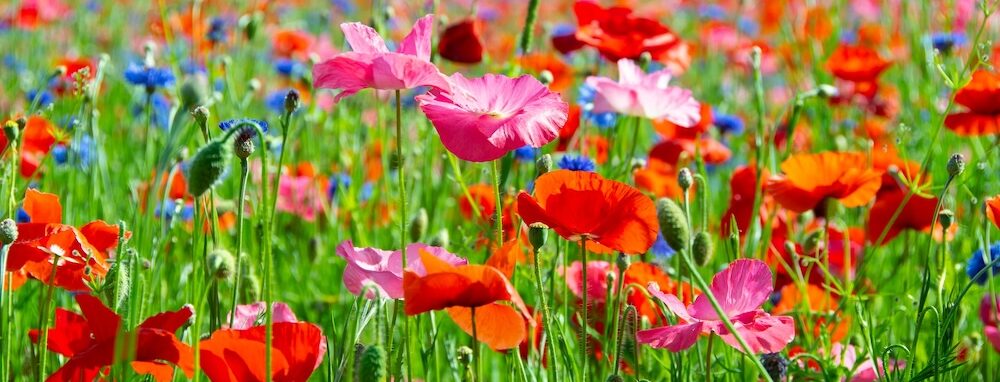
A Comprehensive Guide to British Wildflowers
There's a plethora of wildflowers on British soil, and they each play a role in sustaining our wildlife and pollinators. Find out how to identify some of the most popular examples, with tips on growing them in your garden.
🌱 All important maintenance moments for your lawn during the year. Leave your email and we will send you the lawn calendar for free.
Enter your email
Receive the lawn calendar in the mail
Enjoy a green lawn all year round!

- Order by 2PM = shipped today
- 250.000+ satisfied customers!
- 60 day satisfaction guarantee
We have stunning landscapes of wide open spaces in Britain, accommodating thousands of attractive wildflower varieties. These blossoms, scattered across the countryside, meadows, and woodland areas, add vibrancy to our surroundings and contribute significantly to sustaining the ecosystem.
- The Charm and Importance of Wildflowers
- UK Native Wildflowers: An Overview
- Threats to Wildflowers
- Conservation Efforts for Wildflowers
- Growing Wildflowers at Home
- The Types of Wildflowers in the UK: A Closer Look
- FAQs
Wildflowers tend to be robust and self-sustaining, growing happily without human intervention. So, they offer an excellent choice for a natural-looking garden.
So, if you’re looking to beautify your outdoor space with perennials that bounce back year after year, read on!
The Charm and Importance of Wildflowers
Wildflowers, often seen carpeting meadows and woodland areas with their vivid hues, are more than just a charming spectacle. They play an instrumental role in upholding the ecosystem and supporting various pollinating insects and wildlife.
Pollinators, including bees, butterflies, moths, and wasps, largely depend on wildflowers for nourishment. In return, these pollinators play a crucial role in the life cycle of nearly 60% to 80% of the world’s flowering plant species, many of which provide vital food crops.
Additionally, wildflowers significantly contribute to soil stability, preventing the erosion caused by rainfall. So, they’re not just a pretty addition to a countryside walk — they’re essential in maintaining the health and stability of our environment.
Moreover, their aesthetic appeal positively impacts human mental well-being, providing a serene escape from the hustle and bustle of modern life.
UK Native Wildflowers: An Overview
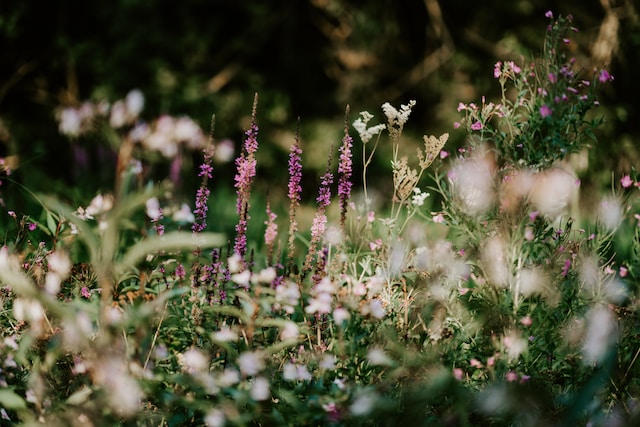
Native wildflowers are species that naturally occur in the UK without human intervention. These wildflowers have adapted over centuries to thrive in the local climate and environment. And they’ve evolved alongside native wildlife, developing distinctive features that attract specific pollinators.
Their whimsical names, such as cowslip, selfheal, ragged robin, and devil’s-bit scabious, reflect their deep-rooted presence in British folklore and culture.
However, despite their importance, native wildflowers are experiencing a decline, with a staggering 97% of UK wildflower meadows lost since the 1930s due to changes in farming methods and land development.
Threats to Wildflowers
The survival of wildflowers and pollinators is intertwined.
The decline in wildflower habitats is in part due to large-scale farming and urbanisation, which has, in turn, led to a significant decrease in pollinators.
This, in turn, disrupts the pollination of flowering plants, including those crucial to the human food supply.
Therefore, conserving wildflowers and our natural environment is not just about preserving the beauty of the countryside but also about safeguarding our food supply and maintaining biodiversity.
Conservation Efforts for Wildflowers

Spreading awareness about the importance of wildflowers is the first step towards their conservation. Also, creating wildflower-rich habitats, even in urban areas, can provide vital support to pollinators.
So, if you add a wildflower corner in your garden, you’re not just adding a lovely splatter of colour, you’re helping support the wildlife that we so rely upon.
Volunteering with community projects aimed at conserving wildflowers or planting them in your own garden can significantly help our pollinators. And learning about different types of wildflowers and their needs can also be a great way to contribute to their conservation.
Growing Wildflowers at Home
Wildflower gardening can be an excellent project to undertake at home, creating a haven for pollinators and wildlife while helping stabilise poor soil.
You don’t need a large space; even a tiny patch in your garden or windowsill can serve the purpose.
However:
Wildflowers can be initially resistant to cultivation, with some varieties particularly selective about their growing conditions. But once established, a wildflower garden typically replenishes itself year after year.
Therefore:
The maintenance of wildflower gardens is relatively simple; you can cut them at the end of the season or leave them to turn to seed naturally, helping next year’s crop.
The Types of Wildflowers in the UK: A Closer Look
In the following sections, we’ll explore some of our most abundant wildflowers in the UK.
Wood Anemone (Anemone nemorosa)
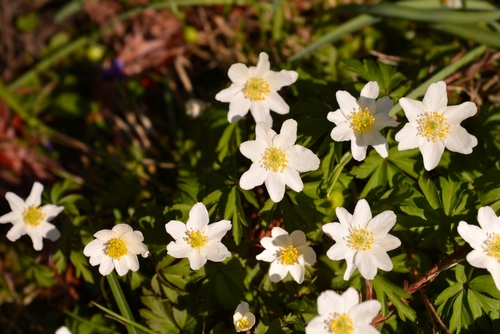
Wood anemone, belonging to the buttercup family, is a common early spring flower redolent of ancient woodlands.
Its white petals with a hint of pink surround a cluster of bright yellow anthers.
These flowers usually bloom from March to May and are often found in woodlands, forests, hedgerows, and meadows.
Dog Rose (Rose canina)
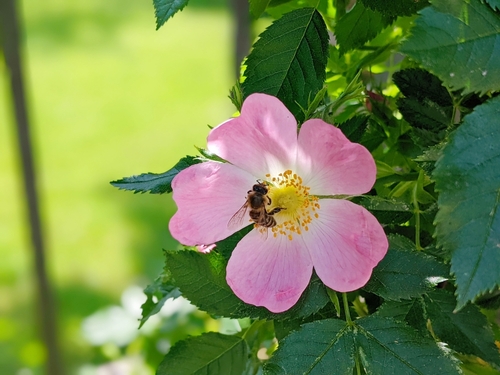
Dog rose, also known as wild briar or wild rose, is a member of the rose family.
It’s a deciduous shrub often grown as a hedge and recognisable by its large pink or white flowers that bloom in summer.
Dog roses are resilient and can thrive in a wide range of conditions, such as poor soil.
Ragged Robin (Lychnis flos-cuculi)
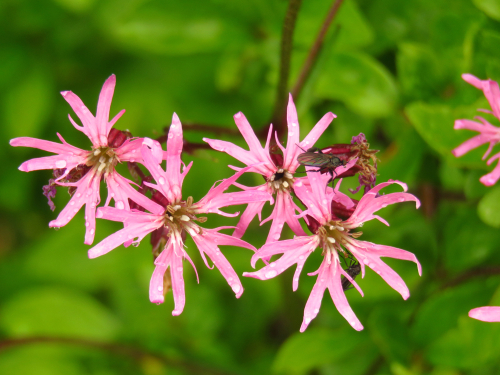
Ragged Robin, a perennial plant in the Caryophyllaceae family, is characterised by its delicate deep pink to magenta colour, fringed petals and slender dark green leaves.
Their flowers, rich in nectar, often attract bees and butterflies. However, the draining of wetlands for farming has caused a significant decline in numbers, starving our precious pollinators of this rich resource.
Ragged Robin is typically found on the banks along roads, in wet pastures, and in meadows. So, these pretty flowering plants are perfect for boggy, shaded garden areas.
Primrose (Primula vulgaris)
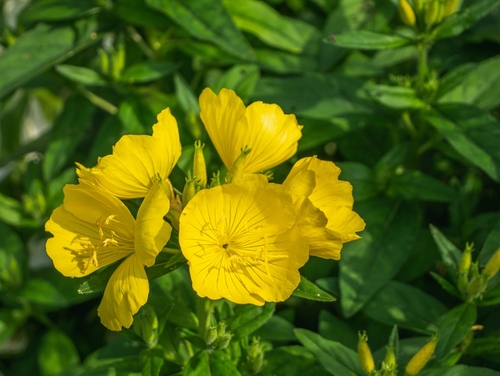
Primroses are a group of flowering plants belonging to the Primulaceae family.
They are widely recognised by their large, milky yellow petals with darker yellow/orange centres.
Primroses are one of the first UK plants to break into blossom each spring, flowering until May. They thrive in partial shade and damp, acidic soil but will grow in full sun if the earth around the roots remains moist.
Common Daisy (Bellis perennis)
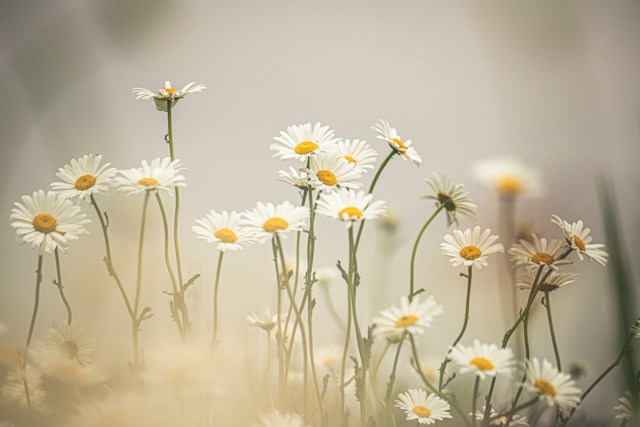
The common daisy is a perennial herbaceous plant belonging to the Asteraceae family.
Daisies are easily identified by their size (10-15 centimetres), delicate white petals, and bright yellow middle.
You’ll find the common daisy all over Britain during spring and summer, appearing in lawns and flowerbeds. If you cultivate daisies, they prefer well-draining soil and full sun.
Lily of the Valley (Convallaria majalis)
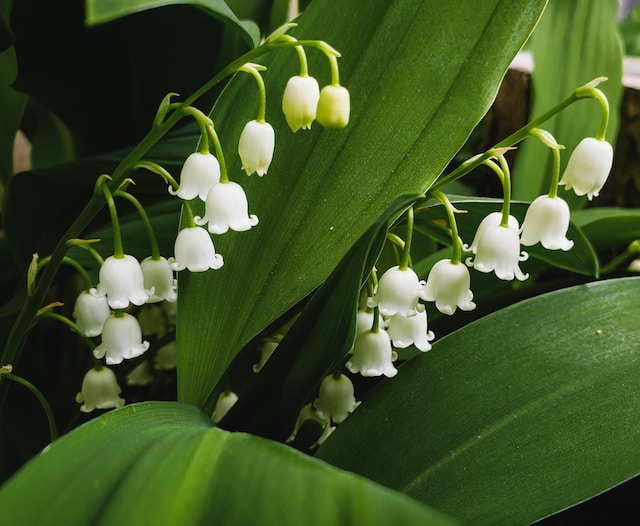
Lily of the valley is a stunning perennial recognised by its bell-shaped, white flowers and fresh, spring-like smell.
However, this plant’s berries are poisonous, so keep pets and children well away.
Often considered invasive in the Americas, Lily of the Valley is a fast grower and can overtake other vegetation given the opportunity. So, keep an eye on the spread.
You’ll find Lily of the Valley in chalky woodland soils. However, new plants will struggle to establish in cold, wet conditions. So, I recommend planting the crowns in pots in March and growing them indoors before transplanting them outside during the summer.
Cornflower (Centaurea cyanus)
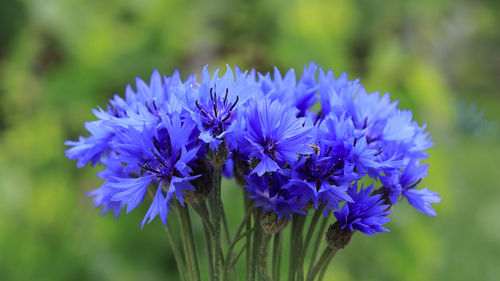
Cornflowers, belonging to the Asteraceae family, are well-recognised for their vibrant purple two-tiered flowers. However, they can also be pink, white, red and pink.
Cornflowers first flower at the beginning of summer, continuing to bloom for around ten weeks from June to September.
Favouring sunny positions, cornflowers require fertile soil with plenty of organic matter that holds onto moisture without becoming waterlogged.
Snowdrops (Galanthus nivalis)
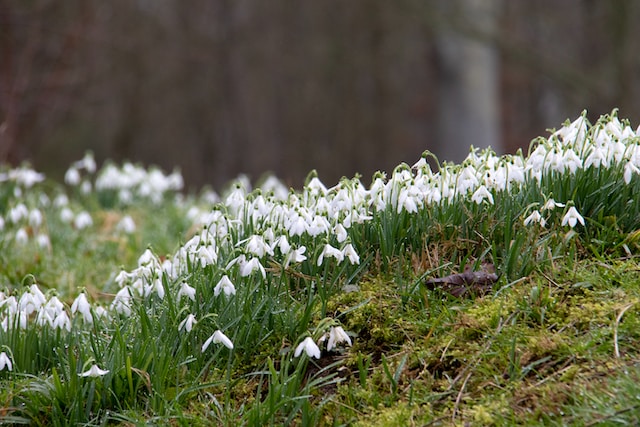
Snowdrops are small, bulbous perennial plants from the Amaryllidaceae family.
These abundant plants produce pretty white flowers between January and early March and can be found in numerous places, including woodlands, riverbanks, parks, gardens, and meadows. They prefer damp, shady spots underneath deciduous trees and shrubs, but they’ll also grow in open areas as long as the soil remains moist.
They’re most likely found in shaded areas and like plenty of organic matter in the soil. Try adding leaf mould for optimal results.
Foxgloves (Digitalis purpurea)
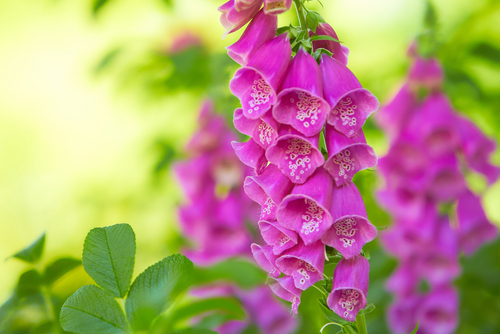
Foxglove is a well-known wildflower across Britain and belongs to the Plantaginaceae family.
They have a distinguishable appearance: Tall up-right spikes and tubular flowers that are usually a pretty pink or rich purple.
Foxgloves typically flower from May to July and will spread if you leave the blown flowers to turn to seed.
However, be careful not to touch or consume wild foxglove as it is poisonous.
Common Bluebell (Hyacinthoides non-scripta)

Bluebells are a perennial purple/blue bell-shaped wildflower in the lily family.
They tend to flower from late March to early May, but it depends on the ambient conditions — they can appear as early as January if there’s been a mild winter.
The initial bluebell bloom often marks the beginning of spring.
FAQs
We have an abundance of wildflowers in Britain, from bluebells and snowdrops to foxgloves, cornflowers, and Lily of the Valley. Other native British wildflowers include Stinking Iris, Stinking hellebore, dandelion, buttercup, primrose, and daisy.
There are more than 1800 wildlife species in the UK, including common wildflowers like daisies and wood anemones. However, we also have a wealth of rare wildflowers on British soil, including several rare orchid species, such as the Ghost orchid, Lady’s Slipper orchid, and Lady orchid. Other rare wildflowers include the spreading bellflower, Spiked star-of-Bethlehem, and Crested cow-wheat.
Much of our wildlife and pollinators rely on wildflowers in the UK. They help sustain pollinating insects such as bees and wasps, but they also help to keep the soil well-draining, nutritious, and productive. Many UK wildflower species are under threat of extinction, often due to intensive farming methods and green belt development.
Any questions?
I hope you’ve got all the info you need to make an informed decision about which wildflowers to cultivate in your garden. But if you have any questions, don’t hesitate to get in touch.
Or check out our super-comprehensive Help & Advice section for a wealth of expert gardening and lawn care tips.
Thanks for reading!
-
Orchids: A Complete Guide on How to Care for ThemWant to give your orchid the best possible care? Discover essential tips from placement to watering and pruning. Learn everything you need to know!Read more
-
Growing Wisteria Made Simple: From Planting to Perfect BloomsWith blossoms like a purple waterfall, Wisteria sets an almost magical and colourful mood. If you want to grow this beauty in your garden, you’ll need a bit of patience. Don’t worry, it will most definitely pay off.Read more
-
How to Build a DIY Greenhouse: A Practical Guide for Smart SpendersImagine extending your growing season throughout the year, nurturing tender plants regardless of the weather, and creating a personal garden sanctuary. This is precisely what a DIY greenhouse offers you. Let’s learn how to build one.Read more
-
How to Grow Eucalyptus in British GardensWith a little love and care, eucalyptus trees can thrive in English gardens. Since they don’t germinate well without proper help, there are not considered invasive. So, there is no reason not to plant them if you enjoy their looks.Read more
-
Transform Your Garden with All-Year-Round Flowering PlantsDid you know you can enjoy blooming flowers even in January? With the right selection of all year round plants, there’s no need to wait until spring to add some colour to your garden.Read more
-
How to Create a Butterfly Garden: A Simple Guide for British GardensThe UK's butterfly population includes 59 different species. These beautiful winged creatures face a steady decline because of habitat loss, pollution and changing weather patterns. Your garden can become a vital link between nature reserves and natural habitats. Let’s explore how.Read more
-
Volcanic Rock Dust for Your Garden—Application and TipsDid you know that volcanic rock dust is a brilliant organic soil improver? This article explains exactly what it's good for and how to use it properly.Read more
-
How to Use Landscape Fabric ProperlyIf weeds or erosion in your garden are troubling you, landscape fabric might be the solution. We’ll explain how and when to use it properly, just keep on reading.Read more
Leave a comment
Your answer will be displayed on the site and the interested party will be notified by email.
Leave a comment
Have a question or want to share your experience? Leave us a comment.

- Order by 2PM = shipped today
- 250.000+ satisfied customers!
- 60 day satisfaction guarantee

- Order by 2PM = shipped today
- 250.000+ satisfied customers!
- 60 day satisfaction guarantee

🌱 All important maintenance moments for your lawn during the year. Leave your email and we will send you the lawn calendar for free.
Enter your email
Receive the lawn calendar in the mail
Enjoy a green lawn all year round!






















Comments (0)
There are no comments yet. Well then, what are you waiting for to
Be the first to write your comment!inaugurate this pretty page?
Do you have some comments?